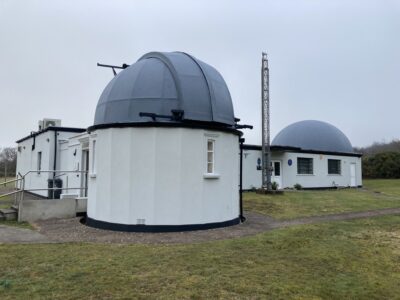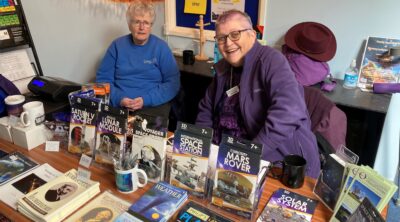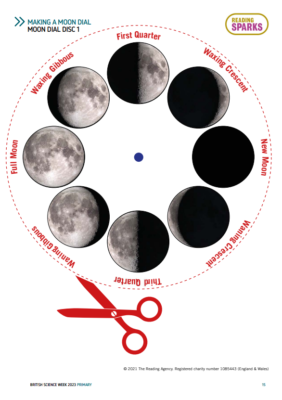 The Norman Lockyer Observatory (NLO) in Sidmouth, Devon, is a historical observatory and home to an active amateur astronomical society. It is a centre for amateur astronomy, meteorology, radio astronomy and the promotion of science education. It is regularly open to the public, staffed entirely by volunteers.
The Norman Lockyer Observatory (NLO) in Sidmouth, Devon, is a historical observatory and home to an active amateur astronomical society. It is a centre for amateur astronomy, meteorology, radio astronomy and the promotion of science education. It is regularly open to the public, staffed entirely by volunteers.
To mark International Day of Human Space Flight (12 April), we hear from David Strange, Chairman at the NLO about its stellar British Science Week Family Day – packed with rocket launches, planetarium shows, hands-on science activities and storytelling sessions – to help local children and families explore our connections with the universe.
By David Strange
This year, British Science Week ran with the theme of ‘Connections’. So, for our annual Family Day event on Saturday 18 March, we explored our connections with the universe through our programme for the day, titled: ‘We are all Star Stuff’.
There was plenty to entertain young minds (who attended for free) with talks, planetarium shows, storytelling sessions, hands-on-science demos, historic telescope tours, rocket launching and meteor detecting.
Dr Des Howlett, Director of the Norman Lockyer Observatory, gave the first talk, ‘Connecting stardust: how everything we see is made from the stars’, explaining how all the elements that are heavier than hydrogen are fused in the stars.
Amy Scarr, a student from Colyton Grammar School, gave a wonderfully researched and fascinating talk about how we might be able use the DNA of tardigrades (microscopic eight-legged animals that have been to outer space!) to help us survive long-term space voyages.
Dave Alexander, a volunteer at NLO gave two planetarium shows to a full house, followed by two storytelling sessions under the stars by our regular storyteller Mike O’Leary, aided by fellow volunteer Mac Currie.
Students from Colyton Grammar School had a great variety of hands-on science interactive displays in our Jeanne Edyvean Centre, and our own NLO Astro Scouts displayed their work on the Tyndall effect (the scattering of light as a light beam passes through a colloid) in the Committee Room.

Outside, Phil Lynch, Head of Physics at Colyton Grammar School, hosted three rocket launches featuring rocket bodies all made on the day by visitors. Meanwhile, volunteers Pete Youd and Mike Hutchings were showing visitors how to safely observe the Sun through Hydrogen-Alpha filtered telescopes (used to observe the sun in high resolution) and a good number of solar prominences (large, bright features extending outward from the Sun’s surface) could be seen around the periphery of the solar disk.
Our historic telescope domes were all open to the public, with presenters telling stories of their historical significance and our understanding of how we learned what stars are made of.
In the Lockyer Technology Centre, long term NLO member Ken Bailey spent the day explaining how we detect meteors and monitor the Earth’s magnetic field. He also showed our recently installed Blitzortung lightning detector in operation and how we can detect lightning storms all over Europe.
The last talk of the day was given by science writer and author Jon Evans who led us through the top 10 Big Ideas in science in the manner of Top of Pops.
The event was very popular, with 300 children and adults attending on the day.
Many thanks to our volunteers and Colyton Grammar School who make this annual event such a success.
To read more and see more photos from the day, check out this piece in the Sidmouth Herald.
Find out more about British Science Week
 Astronomy and space exploration are exciting STEM* topics that we know children and young people are excited about, so we offer resources to help them explore further. Who knows where it could take them, the sky is not the limit, go for the stars!
Astronomy and space exploration are exciting STEM* topics that we know children and young people are excited about, so we offer resources to help them explore further. Who knows where it could take them, the sky is not the limit, go for the stars!
Primary school aged children will find ‘Making a moon dial’ in the British Science Week 2023 Primary activity pack (Page 14). This low-resource activity encourages children to look in their school or local library for books about the moon, to learn more about our closest celestial neighbour. Using the discs provided, they can then make their own moon dial to learn about it’s phases. They’ll know their waxing gibbous from their waning crescent in no time.
For secondary school students, there’s a Bronze CREST Award. ‘How do rockets work?’, in the CREST resource library. This practical project (designed for students around 11-14-years-old but can be adapted to suit older children) has students investigating the physics of rocket flight, then building their own spacecrafts to test their newly learned theories.
If you’d like to learn more about space flight, we know someone who can help! Our previous president and space scientist, Dr Maggie Aderin-Pocock spoke about the future of human exploration of space at her presidential address at the 2021 British Science Festival. Read our coverage of her talk here.
*STEM is an acronym for science, technology, engineering and maths